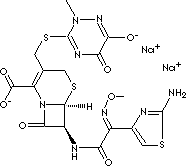PRODUCT IDENTIFICATION
74578-69-1 (Disodium)

H.S. CODE
TOXICITY
SMILES
Cn1c(nc(=O)c(n1)[O-])SCC2=C(N3[C@@H]([C@@H](C3=O)NC(=O)/ C(=N\O C) /c 4csc(n4)N)SC2)C(=O)[O-].[Na+].[Na+]
CLASSIFICATION
EXTRA NOTES
A broad-spectrum cephalosporin antibiotic with a very long half-life and high penetrability to meninges, eyes and inner ears. [MeSH]
Other
RN: 104376-79-6 (disodium hemiheptahydrate), 74578-69-1 (dihydrochloride hemiheptahydrate)
PHYSICAL AND CHEMICAL PROPERTIES
AUTOIGNITION
NFPA RATINGS
REFRACTIVE INDEX
EXTERNAL LINKS & GENERAL DESCRIPTION
USA.gov - Ceftriaxone
Wikipedia Linking - Ceftriaxone
Google Scholar Search - Ceftriaxone
U.S. National Library of Medicine - Ceftriaxone
PubChem Compound Summary - Ceftriaxone
Drug Bank - Ceftriaxone
KEGG (Kyoto Encyclopedia of Genes and Genomes) - Ceftriaxone
ChEBI (http://www.ebi.ac.uk/chebi/) - Ceftriaxone
NCBI (http://www.ncbi.nlm.nih.gov/) - Ceftriaxone
EPA - Substance Registry Services - Ceftriaxone
Local:
Cephalosporin: any of a group of broad-spectrum derived from species of fungi of the genus Cephalosporium and are related to the penicillins in both structure and mode of action but relatively penicillinase-resistant antibiotics. These antibiotics have low toxicity for the host, considering their broad antibacterial spectrum. They have the active nucleus of beta-lactam ring which results in a variety of antibacterial and pharmacologic characteristics when modified mainly by substitution at 3 and 7 positions. Their antibacterial activities result from the inhibition of mucopeptide synthesis in the cell wall. They are widely used to treat gonorrhea, meningitis, pneumococcal, staphylococcal and streptococcal infections. The cephalosporin class of antibiotics is usually divided into generations by their antimicrobial properties. Three generations of cephalosporins are recognized and the fourth has been grouped. Each newer generation of cephalosporins has broader range of activity against gram-negative organisms but a narrower range of activity against gram-positive organisms than the preceding generation. The newer agents have much longer half-lives resulting in the decrease of dosing frequency. Accordingly, the third-generation cephalosporins can penetrate into tissues well, and thus antibiotic levels are good in various body fluids. Third-generation cephalosporins are more active against gram-negative organisms but less active against gram-positive organisms than second-generation agents; examples are cefoperazone, cefotaxime, ceftriaxone, ceftazidime, ceftizoxime, and moxalactam.
APPEARANCE
ASSAY
96.0~102.0% (Ceftriaxone Sodium ;as anhydrous basis)
pH
HEAVY METALS
20ppm max
OPTICAL ROTATION
5kgs - 20kgs
HAZARD OVERVIEW
GHS (Globally Harmonised System) Classification: Skin irritation. Eye irritation. Respiratory sensitization. Skin sensitization. Specific target organ toxicity - single exposure. Hazard statements: Causes skin irritation. May cause an allergic skin reaction. Causes serious eye irritation. May cause allergy or asthma symptoms or breathing difficulties if inhaled. May cause respiratory irritation.
GHS
Danger
PICTOGRAMS


HAZARD STATEMENTS
H315-H317-H319-H334-H335
P STATEMENTS
P261-P280-P305 + P351 + P338-P342 + P311
![]()
RISK PHRASES
36/37/38-42/43
SAFETY PHRASES
26-36